October 12, 2021 – Pueblo Tailwater (The Hatchery Hole to the Double Tree Hole)
Flows: 69 cfs.
Water Temp: 60F @ 9a.
Water clarity: ~2’ – off color.
Air Temp: 41F @ 8:30a – 57 @ 4p.
Hatches: Trico 8a – 2p, Caddis here and there 1p – 2p.
Flies: #10 Chubby Chernobyl, #16 Red Copper John, #24 Black Flashback RS2, #24 Mercury Beatis, #24 Top Secret Midge, #18 Guide’s Choice Hare’s Ear, #20 Mercury Pheasant Tail, #20 Blood Midge, #22 Chocolate Thunder, #24 Trico Parachute, #24 Trico Spinner, #22 Green Zebra Midge, 20 Bucksin Caddis, #18 Red Wire Worm, #24 Purple JuJu Beatis, #24 Black Two Bit Hooker.
Top producers: Mercury Pheasant Tail, Blood Midge, Black Two Bit Hooker, Chocolate Thunder, Red Wire Worm, Top Secret Midge, Bucksin, Green Zebra Midge.
The author with a 19" cutbow.
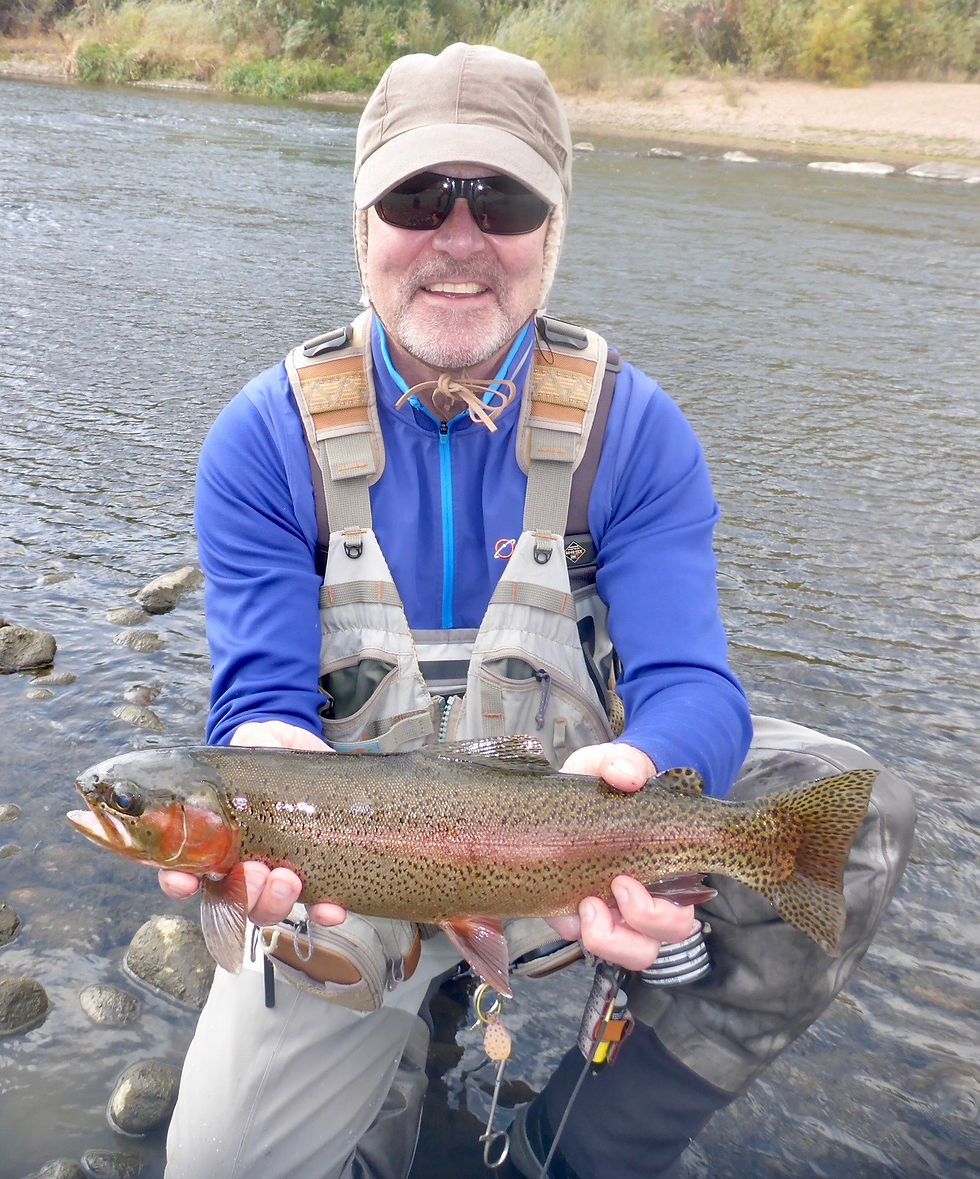
Brian Kenney.
It’s 6:30a and still dark out and we’re heading south on I25 – destination Pueblo, Colorado. It’s become our annual migration south. Like the birds we’re looking for warmer weather. Unlike the birds, we’re only staying for the day – not the whole season. We’re going there to fish.
The Arkansas River below the Pueblo Dam is referred to as the Tailwater. I was talking to a guide at one of the local fly fishing shops a few years ago and was commenting on the cold conditions that we were encountering in the mountain rivers. I think I was saying something about freezing our you-know-whats off – and he recommended to try the Tailwater.
The weather in Pueblo is generally warmer than the Denver Metro area and definitely a lot warmer than the mountain fishing spots that we go to. Also, there is a lot more bug activity in the winter there. It’s common for beatis – BWOs specifically – to hatch all winter long. And you have midges hatching yearlong too. The river has been improved with various structures that favor trout habitat and there are sculpins – small fish – and other small fish for the trout to feed on.
Taken all together and the Tailwater is a fantastic fishery.
We only fish it in the winter because the flows are raised quite high in the summer to support the downstream water demand. The only way to fish it then is by boat – and neither Brian nor I have a boat. Added to that one small detail - it gets very hot in the summer in Pueblo – so wade fishing in the mountains makes more sense.
Come fall and winter though and we’re both excited to fish with the Tailwater. The river has plenty of rainbow, cutbow, and brown trout – and large ones at that. It’s not unusual for both of us to catch 17” and 18” fish – and it’s not uncommon to land a 19” or 20” one too. The rainbows and cutbows have distinct coloration with bright pinkish red, to deep red and orange accents.
There were a couple of fall storms that came into Colorado this week and the forecast for the Denver Metro was rain and cold temperatures. The mountains were forecasted to have snow and even colder temperatures. So we headed south and we both were anticipating landing big trout!
Last week we snuck in a fall trip to the Dream Stream. I say snuck in because it starts getting cold and weather gets hairy on the Dream Stream in the fall. Winter – well I’ve never tried it. The Dream Stream is renown for big fish – especially if the lake fed browns, rainbows, cutbows or kokanee salmon are moving into it to spawn. The browns and kokanee are starting their spawning runs now so we “Dream’n” of landing big fish! We did get some decent size ones – but we also got a bunch of small fries.
That’s why we were looking forward to landing some big ones at the Tailwater. There must be some phenomena that I’m not aware of regarding small fry trout. We encountered a bunch on the Tailwater – much the same as we did on the Dream Stream. Sometime they just seem to be all over the place. It actually becomes annoying to catch them because the squirm around so much that they get your flies all tangled up. Why are they there sometimes in large numbers – and other times not? Not sure if there is an answer, but I want to research it.
A trico. (The sun caused an over exposure. It may have been a female - she had a light olive coloration on her body and black head.)

As I waded across the river heading to the Hatchery Hole first thing in the morning – I saw a bunch of fish rising. I couldn’t quite identify what was hatching at the time – but it looked like some type of mayfly. When I got to the opposite shore I decided to rig up my dry fly kit and go after some. As I was stringing line into my rod eyelets a Trico landed on my rod. He was just sitting there and left no doubt as to what was hatching.
I found out one time that you can’t really tell how big the fish are when they’re sipping flies off the surface. On that occasion I had a 20”+ rainbow take my fly – and I was totally unprepared – and very happy! I thought it would be in the 15” range – judging just by the small wake he made as he sipped the flies.
As I observed the rising fish – it was pretty clear to me that there were a lot of small fish. But I thinking back to the 20”+ rainbow – I thought there may be some bigger ones, maybe in the 12” range. So I waded back out with a Trico Parachute and a Sparkle Wing BWO tied on. After casting into an area of about 100 yards I was sure they were all small fish – in the 6” range. Not what I was after.
But once I start casting to even the small fries – I’m determined to land one. It’s either my competitive nature or I’m just stubborn. I don’t know which. Little fish are not easy to catch. They strike very quickly and my reaction is to set very quickly. It just doesn’t seem to work as good as when you can see a larger fish rise to take the fly. Then you have some time to prepare. Anyway I continued to cast to these small fries until I finally landed one. It was about 6” and it took my Trico Parachute.
With that finally out of my system – I waded back over to the shore to gather my stuff. I then headed upstream. Brian was sharing the Hatchery Hole with a regular – Terry - who fishes it almost every day till 9a. Brian had netted a 15” rainbow by the time I walked up to the hole. Terry had landed a couple too.
A hefty 17" rainbow. They are brightly colored too!
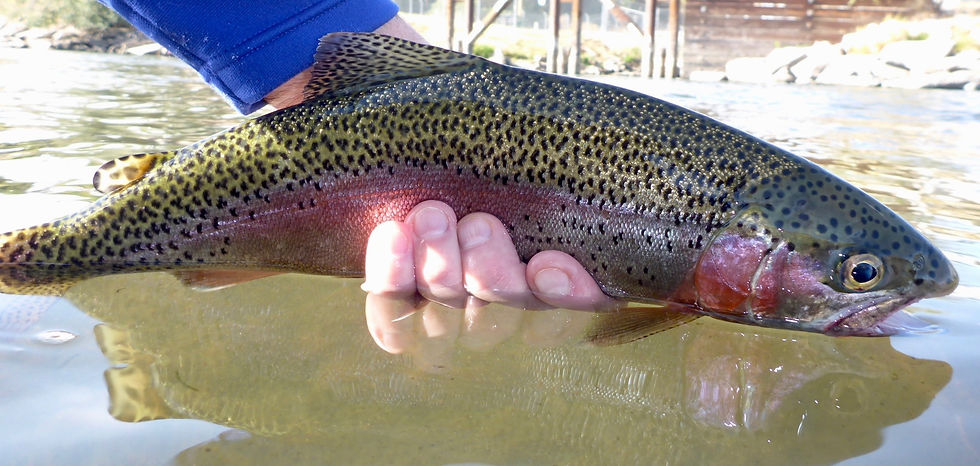
After a quick chat with Brian – I continued to move upstream to the Cliffs Run. The run starts with a few troughs of deeper riffles that feed into a man-made weir (a line of large boulders that are stacked in a line across the river). The weir feeds into a deep, slow pool. In the past we’ve caught fish in the troughs above the weir and in the pool below it.
During a hatch the fish are usually rising in the pool and it’s a good place to catch them on dries. And they were rising as I approached, but I ignored them because they looked like more small fries. Instead I headed up above the weir to fish nymphs in the troughs. It wasn’t long and I had one on. It was a small fry! He was so small that he didn’t even move my indicator.
After a few more small fry I noticed that it was 9a and Terry had left. So I gathered my stuff and headed to join Brian in the Hatchery Hole. We stayed in that spot for a couple of hours. During that time I finally landed a “big” fish. He was a stout 17” rainbow. I also lost a handful of nice fish. One was a pretty big one – looked to be in the 19” to 20” range. He broke off though – and upon further inspection my tippet broke. I think he ran my line across one of the boulders that are strewn throughout the hole and snapped it. A couple of times I was raising my line to recast and a fish would be on. But without a good hook set – they were able break free.
Brian was having more success landing the fish – netting a few rainbows and a couple of suckers. We were getting them on Green Zebra Midge, Top Secret Midge, Bucksin Caddis, Black Two Bit Hookers, and Chocolate Thunders. All in sizes 22 to 24.
The Tailwater runs through the Pueblo Reservoir State Park and the park is filled with various forms of wildlife. While in the Hatchery Hole we were joined by a deer drinking in the shallow water above us and a Blue Heron. The Heron was fishing too. It’s interesting to watch the Heron stalk fish. Their movements are very slow, almost imperceptible as they sneak up on the fish. They remind me of a praying mantis. Then they strike very quickly.
This rainbow has a pinkish stripe and more of an orange color to his cheeks.

With the fishing slowing – we headed downstream to the Valco Ponds Run. We were hoping that it would be open – but as it was, we didn’t have anything to be concerned about. The river was deserted. Besides Terry – I only saw one other fisherman the whole day. A pleasant surprise – but pretty unbelievable. There was high wind warnings for the day and maybe that kept the crowds home.
At the Valco Ponds Run we were greeted by - what else - small rising fish. I was first to arrive and had one on within the 5 minutes. Once Brian got there – we covered the run as we normally do hoping to find some bigger fish. The water was off color and we could only see into the river about 2’ – making sight fishing difficult, if not impossible. Both of us know this run and we casted to all the likely spots.
One of them is a seam between two downed tree trunks. As I drifted my flies close to the submerged tree trunk on the south side of the river I got a hit. And it wasn’t a small fish. I could tell right away it was a big fish – bigger than most that we catch here. He first took me downstream about 40 yards – then back upstream toward the downed trees. Head shakes and runs the whole way. I couldn’t get his head up and never saw the fish. All of a sudden my line went slack as he headed toward the downed trees.
What!
Here's a small fry - about 6". He took a trico spinner.
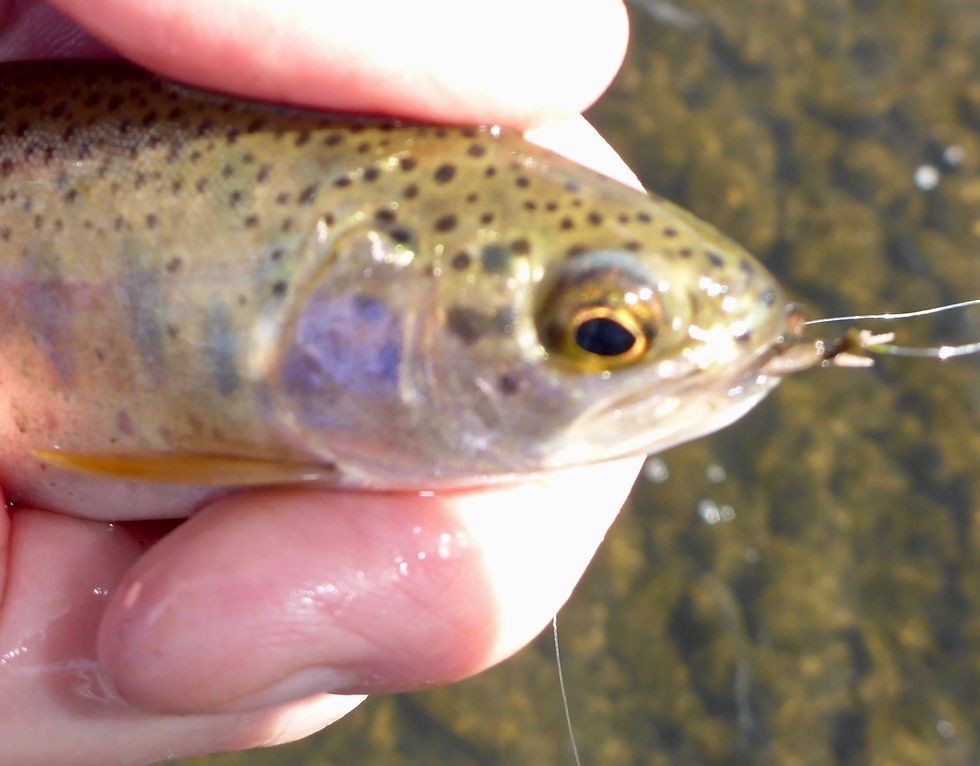
Fish do break off – it happens – but I had this guy solidly hooked up. What happened? As I reeled in my flies I could see that they all were still there. My line didn’t break. As I inspected my flies I noticed the hook on my Black Two Bit Hooker broke at the bend of the shank. That explained what happened – but it didn’t make me feel much better. That was one hell of a fish. Brian and I suspected it was a bull brownie. And a BIG one.
After a bit the run seamed to dry up so we headed downstream to Tom’s Run and the Double Tree Hole. As we waded into Tom’s Run, Brian took the north side and I took the south side. And what do you know – Brian quickly hooked up another small fry! They were everywhere.
After covering the run, Brian headed down to the Double Tree Hole and I worked my way to a couple of pools formed by a weir and some very large boulders. These spots have produced in the past and sometimes hold pods of fish. As I moved to the lower part of the run I spotted some large fish. The first ones I spotted all day. They were in the upper column and moving from the riffles back into the deeper pools.
A 15" female who took the Blood Midge.
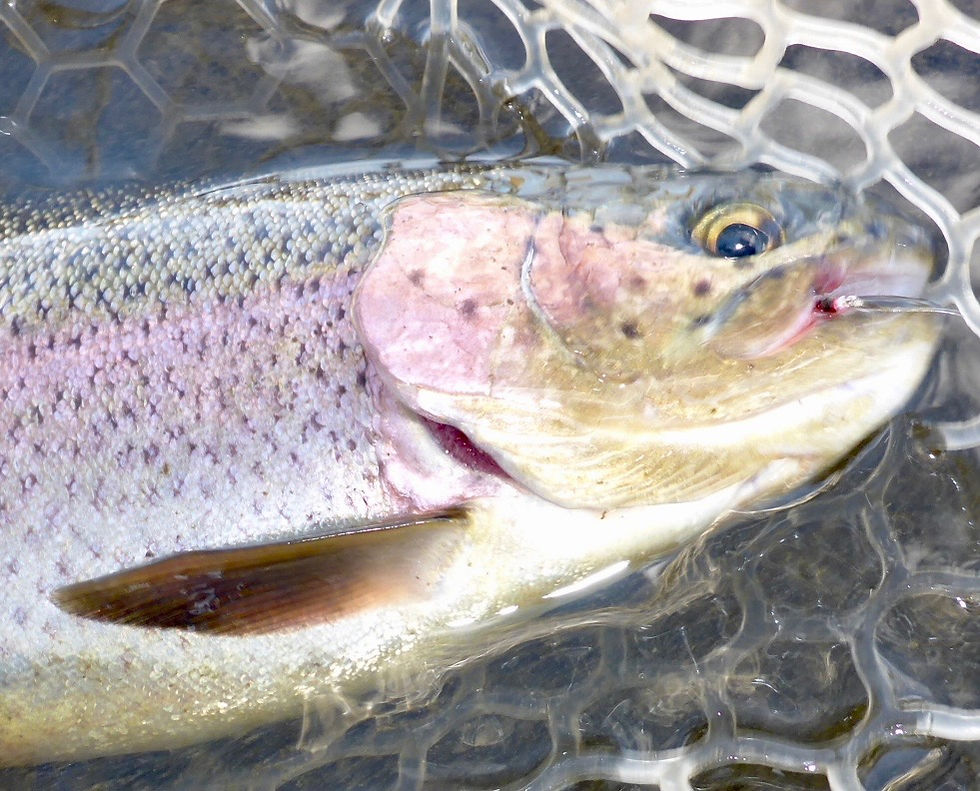
They were dark spots in the water and one of them was a really nice sized one. He was my target. I casted my flies into the shallow riffle and let them drift into the deep pool. On my second cast I had a fish on. It wasn’t the big one I was targeting, but a 15” rainbow. Better than a small fry!
The wind wasn’t a factor until about 1p. Then it became a huge factor. Not sure what the speed of the gusts were – but it seemed at least 35mph to 40mph. At times it would push my body and I’d have to put my foot out to steady myself. Not the best conditions to wade in. Casting and mending our line became very, very difficult.
At about this time Brian came up to join me. I was moving across the river trying to change my casting angle hoping the wind would help me by blowing behind me instead into me. It worked making my casting easier and more accurate, but I didn’t get any interest. From my vantage point – and with the wind ripped water – I couldn’t see into the water and didn’t know if the fish were still there or not.
Just then Brian hooked one up in the back end of the deep pool. It was a nice one too. He fought it for a bit but somehow the fish broke free. After giving that spot another 15 minutes or so, Brian moved upstream a bit and I moved back into my original position. From there I could still see the fish – they hadn’t left. The big one was still in front of a huge boulder in the deeper pool and the other one was off to the side closer to the front of the pool near where the riffles feed into it.
A close up of the 19" cutbow.
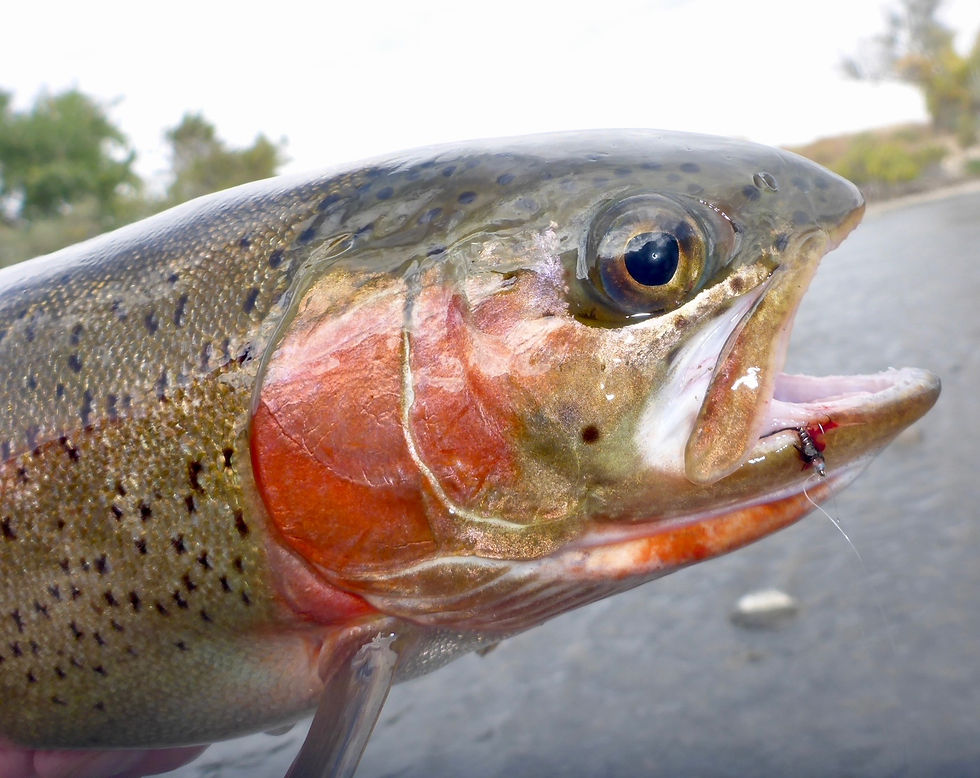
After several – or more – casts into their feeding lanes, I saw the fish in the front move as my flies were near him. I instinctively set the hook and had him. I could feel some heft and the fight was on. I led him back into the pool of slow water. That way I only had to fight him – not him and the current. After a couple of runs I was able to get his up and led him to the net. A very nice, hefty 19”, brightly colored cutbow. That’s what I was after!
We continued to fish the run for a bit longer then decided to walk back up to the Valco Ponds Run. It was getting late and it was on the way to the car. The wind was still howling when we arrived. Besides a great fishing experience – this part of the river is known for getting snags. With all the river improvements there are a lot of boulders, logs, tree stumps and other debris in the river that you invariably get snagged on.
I lost all my flies on a snag before leaving Tom’s Run. So when we got to the Valco Ponds Run I sat on the bank and proceeded to retie my flies. While I was doing that, Brian hooked up four nice fish. But somehow they all were able to break free. When I finally had all my flies on Brian gave up his spot for me to try. But there was nothing doing. Then I got snagged up on the downed tree that spans almost the width of the river – and lost all my flies again. Ugh!
Rather than tie on new flies I decided to call it a day and headed to the car. It was time to go anyway. Brian soon joined me.
Fishermen often loose items while fishing. Brian finds stuff in the river and along the riverbanks all the time. I usually don’t find stuff – but seem to lose my fair share of it. As I was putting my gear in the car I realized I couldn’t locate my camera. On jeez!
This is where I dropped my camera. If you look closely you will see a Blue Heron in flight in the center of the picture just at the opposite shore.
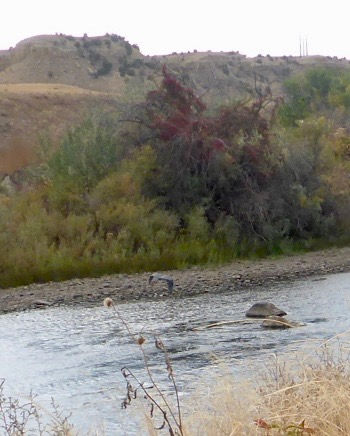
We went back to the Valco Ponds Run to see if it fell out of my pocket there. We didn’t see it anywhere and we were going to walk down to Tom’s Run to see if it was there. Then I remembered that I took a picture of a Blue Heron while walking from Tom’s Run to the Valco Ponds Run. That was the last time I saw it.
At the time we were on the other side of the river from where I took the picture and neither of had our waders on. So we walked back to the car and drove around the park to the other side of the river. I was hopeful that I just dropped it as I was putting it in my pocket after taking that picture. Once we parked I walked – very quickly – to the spot where we were when I took the picture – and there it was - lying on the ground! Yes – I felt complete again.
As we were driving down I25 in the morning I had mentioned to Brian that even though the Tailwater is beginning to get recognized for it’s excellent fishing – I still think it’s underrated. Of all the places we have fished over the past three years – the Tailwater is right there at the top of the list of places that consistently produce fish in numbers and size.
The fall foliage in full color.
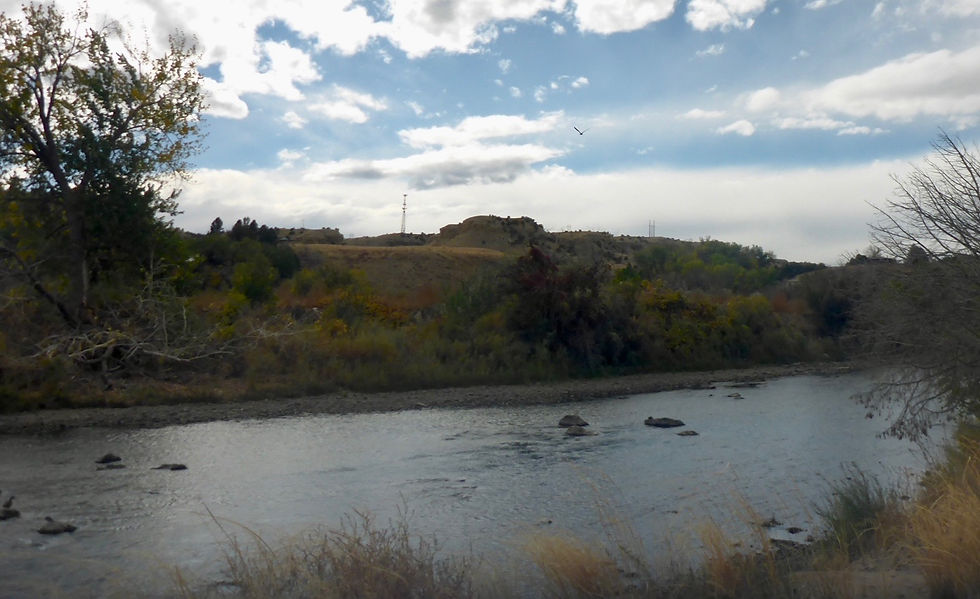
Even though the small fries were out in numbers and were sometimes annoying – we still caught a good number of larger fish and had one 19” fish in the net. And the cutbows had that distinctive, bright coloration.
We’re both looking forward to spending more time on the Tailwater this fall and winter!
Commentaires